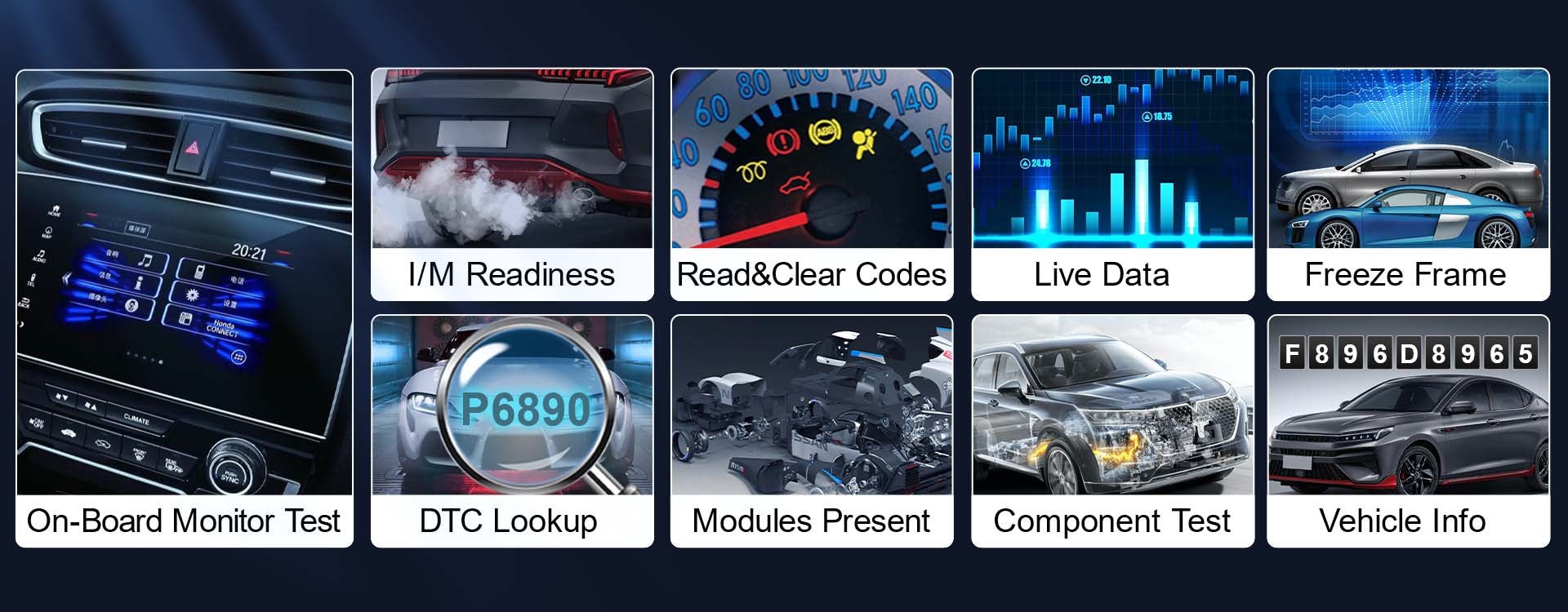The dreaded ABS (Anti-lock Braking System) light on your dashboard can be a cause for concern. This crucial safety system is vital for maintaining control of your vehicle, especially in emergency braking situations. When that warning light illuminates, many car owners immediately think of expensive trips to the mechanic. But could an OBD2 scanner, a tool often touted for its diagnostic capabilities, offer a solution? The answer is yes, an OBD2 scanner can reset ABS codes, but it’s not always that simple.
This guide, brought to you by the automotive experts at keyfobprog.com, will delve into the world of OBD2 scanners and their ability to interact with your car’s ABS system. We’ll clarify the capabilities of these devices, explain how they work with ABS codes, and guide you on how to use them effectively. Whether you’re a seasoned DIY mechanic or a car owner looking to understand your vehicle better, this information will empower you to take a more informed approach to your car’s maintenance.
OBD2 Scanner Basics: Decoding Your Car’s Signals
Think of an OBD2 scanner as a translator for your car. Modern vehicles are equipped with sophisticated computer systems that constantly monitor various components. When something malfunctions, these systems generate diagnostic trouble codes (DTCs). An OBD2 scanner plugs into your car’s OBD2 port, typically located under the dashboard, and allows you to communicate with your car’s computer to read and interpret these codes.
Here are the core functions of most standard OBD2 scanners:
- Reading and Clearing Diagnostic Trouble Codes (DTCs): This is the fundamental function. Scanners can read both generic and manufacturer-specific codes related to various systems, including the engine and transmission. They can also clear these codes, which often turns off the corresponding warning lights on your dashboard, such as the “Check Engine” light. This functionality is explained further in our article on the best full system OBD2 scanners.
- Real-Time Data Monitoring: OBD2 scanners can display live data from your vehicle’s sensors and systems as you drive. This data can include engine temperature, RPM, oxygen sensor readings, vehicle speed, and more. It provides valuable insights into your car’s performance in real-time.
- Emissions Readiness Testing (I/M Readiness): Before vehicle registration, many areas require emissions testing. OBD2 scanners can check your car’s readiness status for these tests, ensuring all emission-related systems have been evaluated.
While these functions are incredibly useful for general car maintenance and understanding engine-related issues, the capabilities become more nuanced when dealing with specialized systems like the Anti-lock Braking System (ABS).
ABS Codes: Delving Deeper Than Generic Trouble Codes
Understanding the difference between generic trouble codes and ABS-specific codes is crucial when diagnosing brake system issues.
Imagine your “Check Engine” light comes on. Using a basic OBD2 scanner, you might retrieve a code like P0300. This is a generic OBD2 code, indicating a “Random/Multiple Cylinder Misfire Detected.” Standard OBD2 scanners are designed to read and interpret these standardized P-codes (Powertrain codes).
However, when the ABS light illuminates, and you use a more advanced scanner, such as the Foxwell NT809 mentioned earlier, you’ll encounter a different type of code. Instead of P-codes, you might see codes like C0035. This “C” code signifies a “Chassis” code, specifically “Left Front Wheel Speed Sensor Circuit Malfunction.” While any OBD2 scanner can read a P0300 engine code, reading and interpreting C0035 requires a scanner with enhanced diagnostic capabilities, specifically ABS system access.
Here’s a breakdown of why ABS codes are distinct:
- System Specificity: Generic OBD2 codes primarily focus on the powertrain – the engine and transmission, the systems that propel the vehicle. ABS codes, conversely, are dedicated to the braking system and its safety features.
- Complexity and Detail: ABS codes are often more specific and intricate. They pinpoint issues within the ABS system, such as individual wheel speed sensors, hydraulic components, or the electronic control unit. For example, a code like C0110, indicating an “ABS Pump Motor Control Circuit Malfunction,” highlights a problem within a very specific part of the ABS system, which is separate from the engine management system.
- Manufacturer Variations: While generic OBD2 codes are standardized across vehicle makes and models, ABS codes can have manufacturer-specific nuances. A code like C1235 might mean different things for a Ford versus a Honda. This manufacturer-specific language is why not all OBD2 scanners are equipped to read or reset ABS codes – they require deeper diagnostic protocols.
This distinction underscores the importance of using the right type of OBD2 scanner when addressing ABS issues. A basic scanner might not even recognize ABS codes, let alone reset them.
OBD2 Scanners Capable of ABS Code Reset: What to Look For
So, can OBD2 scanners reset ABS codes? Yes, but the key is using a scanner that is specifically designed to interact with the ABS system. Here’s what to consider when selecting an OBD2 scanner for ABS diagnostics and reset:
- ABS System Compatibility: This is the most critical factor. Ensure the scanner explicitly states it supports ABS diagnostics and code clearing. Look for terms like “ABS System Diagnosis,” “ABS Code Reader,” or “Full System Scanner” which often indicates ABS compatibility. Not all OBD2 scanners offer this; it’s a feature typically found in mid-range to advanced models.
- Enhanced Diagnostic Functions: Beyond ABS, some advanced scanners offer even broader diagnostic capabilities. They may also be able to read and clear codes for other safety systems like SRS (Supplemental Restraint System – airbags) and ESC (Electronic Stability Control). These “full system scanners” provide comprehensive coverage of your vehicle’s electronic systems.
- Vehicle-Specific Software and Updates: Due to the manufacturer-specific nature of ABS codes, some scanners offer specialized software or updates tailored to specific car brands. This enhanced compatibility ensures accurate diagnosis and code clearing across a wider range of vehicles. Check if the scanner supports your vehicle’s make and model for optimal ABS system interaction.
Step-by-Step Guide: Resetting ABS Codes with an OBD2 Scanner
Let’s assume you have an OBD2 scanner that is ABS-compatible, such as the Foxwell NT809 or a similar advanced model. Here’s a general step-by-step guide on how to use it to reset ABS codes:
- Connect the Scanner: Locate your vehicle’s OBD2 port. It’s usually situated under the dashboard on the driver’s side, near the steering column. Plug your OBD2 scanner securely into this port.
- Turn on the Ignition (Key On, Engine Off): Turn your car key to the “ON” position. This powers up your car’s electrical systems and the OBD2 port, allowing the scanner to communicate with your vehicle’s computer. Do not start the engine.
- Vehicle Selection: Using the scanner’s interface, navigate to the vehicle selection menu. Choose your car’s make, model, and year. This ensures the scanner uses the correct diagnostic protocols for your specific vehicle.
- Access the ABS System: Once you’ve selected your vehicle, look for a “Diagnosis,” “System Selection,” or similar menu option. From there, you should find an “ABS,” “Brake System,” or “Anti-lock Brake System” option. Select this to access the ABS control module.
- Read ABS Codes: Within the ABS system menu, select “Read Codes” or “Fault Codes.” The scanner will then retrieve and display any stored ABS trouble codes. Note down these codes for reference. Common ABS codes might include C0035 (wheel speed sensor issue) or C0110 (ABS pump motor issue).
- Address the Underlying Issue: Crucially, resetting the ABS code is not a fix. The code is triggered by an underlying problem in the ABS system. You must diagnose and repair the issue that caused the code before attempting to clear it. This might involve replacing a faulty wheel speed sensor, repairing wiring, or addressing hydraulic issues.
- Clear ABS Codes: After you have addressed the root cause of the problem, navigate back to the ABS system menu on your scanner and select “Clear Codes” or “Erase Codes.” This will command the ABS control module to clear the stored trouble codes and, ideally, turn off the ABS warning light on your dashboard.
- Verify and Test: Turn off the ignition, remove the scanner, and then start your car. Check if the ABS warning light remains off. If it stays off, take your vehicle for a short, slow test drive, carefully applying the brakes to ensure the ABS system is functioning correctly and the light does not reappear. If the light comes back on, it indicates a persistent issue that requires further diagnosis and repair.
OBD2 Scanners vs. Professional Diagnostic Tools: Weighing Your Options
When dealing with ABS codes and brake system diagnostics, it’s natural to wonder how OBD2 scanners compare to the professional-grade tools used by mechanics. Here’s a comparison to help you understand the differences:
| Feature | Advanced OBD2 Scanners | Professional Diagnostic Tools |
|---|---|---|
| Functionality | Reset ABS, SRS, and other specialized codes; live data | Deeper diagnostics, module coding, advanced system tests |
| Ease of Use | User-friendly, often designed for DIY enthusiasts | Requires more expertise, training, and technical knowledge |
| Vehicle Support | Wide range of vehicles, but compatibility varies | Broader vehicle coverage, including specialized and older systems |
| Data Accuracy | Accurate for most DIY tasks, including ABS code reading | Highly accurate and comprehensive, designed for professional repair |
| Price | Affordable to mid-range, good value for features | Expensive, significant investment, typically for professional shops |


For many common ABS issues, an advanced OBD2 scanner can be a valuable tool for diagnosis and code resetting, especially for DIYers. However, for complex or intermittent problems, or when deeper system analysis and module programming are needed, professional diagnostic tools and expertise are essential.
When ABS Codes Won’t Clear: Troubleshooting Steps
Sometimes, despite your best efforts, an OBD2 scanner might fail to clear ABS codes. Here are potential reasons and troubleshooting steps:
- Scanner Incompatibility: The most common reason is that your scanner may not fully support the ABS system on your specific vehicle make and model. Double-check your scanner’s manual or the manufacturer’s website to confirm ABS compatibility for your car.
- Persistent Underlying Issue: If the ABS code immediately returns after clearing, or if it refuses to clear at all, it almost certainly indicates that the underlying problem in the ABS system is still present. A faulty sensor, wiring issue, or hydraulic problem needs to be properly repaired before the code can be cleared permanently.
- Special Reset Procedures Required: Some vehicle manufacturers employ specific reset procedures for ABS codes that go beyond a simple “clear codes” command. These procedures might involve specific steps with the scanner or even manual reset methods. Consult your vehicle’s repair manual or online resources specific to your car model for any special ABS reset procedures.
If you’ve confirmed scanner compatibility, addressed the apparent issue, and the ABS codes still won’t clear, it’s advisable to seek professional help. A qualified mechanic has access to advanced diagnostic tools and in-depth knowledge of ABS systems to accurately pinpoint and resolve persistent problems.
Conclusion: OBD2 Scanners and Your ABS System
OBD2 scanners are powerful tools that empower car owners to understand and address various vehicle issues, including problems within the Anti-lock Braking System. While basic scanners are limited to engine and transmission codes, advanced OBD2 scanners with ABS compatibility can read and reset ABS codes, providing valuable diagnostic capabilities for DIY maintenance.
However, it’s crucial to remember that resetting ABS codes is only one part of the process. Addressing the underlying cause of the code is paramount for ensuring your ABS system functions correctly and your vehicle remains safe. Knowing the limitations of your OBD2 scanner and when to seek professional help is essential for responsible car maintenance. Equipped with the right tools and knowledge, you can confidently tackle many ABS-related issues and keep your brake system in optimal condition.
FAQs about OBD2 Scanners and ABS Systems
Can an OBD2 scanner clear the ABS light?
Yes, an ABS-compatible OBD2 scanner can clear the ABS light, provided the underlying issue causing the light has been resolved. Basic OBD2 scanners that only read engine codes will not be able to clear the ABS light. You need a scanner specifically designed for ABS diagnostics.
How do I clear my ABS code using an OBD2 scanner?
To clear an ABS code, connect an ABS-compatible OBD2 scanner to your vehicle’s OBD2 port, navigate to the ABS system menu, select “Read Codes” to identify the codes, then address the underlying issue, and finally select “Clear Codes” within the ABS menu to reset the system and turn off the ABS light.
Can you clear all fault codes with an OBD2 scanner?
No, not all OBD2 scanners can clear all fault codes. Basic scanners are typically limited to powertrain (engine and transmission) codes. To clear codes for systems like ABS, SRS (airbags), and ESC, you need an advanced, “full system” OBD2 scanner that specifically supports those systems. The range of codes a scanner can clear depends on its features and capabilities.
